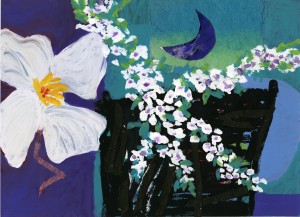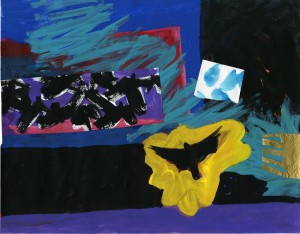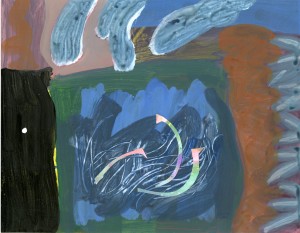An interview by the poet Michael Moore with the artist—his mom—Nora Moore

Nora: The creative process of painting is an intuitive one for me. Exploring the very nature of paint, color, and texture forms ideas from my subconscious. Closeness to nature and past memories come out in surprising ways. I try to find a simple idea much like a Haiku poem.
Michael: So nothing is predetermined?
Nora: Nothing is predetermined.
Michael: Can you talk about how some of this process worked?
Nora: I start by playing with color and pushing paint around, and then – pretty much with what papers are laying on the table and what paint is out there – I start gluing things down, repainting, and then it starts to become an idea. I try to then follow the idea of what it wants to be and not what I want it to be, working with that composition in that way.
Michael: It takes some time…
Nora: It takes a lot of time, sometimes something lays on a table for weeks or a month, then I will suddenly find the right piece of paper and it all falls together.
Michael: Do you sometimes start with an idea you want to do, or do you wait for that to come?

Nora: I have found that if I try to pursue an idea, it does not work. I usually just start with brushwork. It’s very difficult. I’ll start out with very abstract paintings, and then paint over things, letting different brushstrokes show through, and just keep playing with the paint until eventually an idea comes.
Michael: With this work in particular, it seems a lot of it is coming from the subconscious.
Nora: That’s where the idea starts evolving from. I’m not even aware of it. I’m just playing and the subconscious is, I believe, where our creativity lies and it starts coming forward, and then I know what to do.
Michael: I think there’s a lot of commonality among this body of work, that you are looking at nature and you’re making a response to nature.
Nora: I think it all comes from nature. A lot of organic shapes—a flower, the garden, and landscape. Most of this also comes from my years of landscape painting. I’ve been trying to put landscape in a different form, and therefore I think a lot of things get divided up into squares and rectangles like farm fields, and places where we’ve been. Cities, and living here [in Cedar Grove, Wisconsin]—boats and docks. Memories come out.
Michael: Memories and dreams. Seems like you’re playing with some of that, too.
Nora: I believe in dreams. When I try to do this work, I tend to be very representational, and if I think of something that is a dream—our dreams shift and reshapes—and very crazy things get mixed up. You have eggbeaters with a vacuum cleaner or something. I was trying to bring the element of strange imagery and shifting pictures into the artwork so that I didn’t stay so representational.
Michael: In terms of the process there is a lot of layering that happens.

Nora: That’s a process of painting; I find that I throw on a lot of colors on an area I like. What I don’t like is erasing. I don’t have an eraser on my paint brush so I paint over it. I have found that when I leave colors showing through then you get more dimension into your artwork. You leave some things, you obliterate things. Those layers all help create the texture in the pieces of artwork.
Michael: Let’s talk about your history. When did you know you wanted to be an artist?
Nora: I really don’t remember not having a crayon in my hand. I believe one thing my mother taught me how to do was shade colors in my coloring book instead of just using one color. It started there, learning how to blend things. But I was always drawing. I copied all the Mickey Mouse pictures, the Bambi pictures. I’ve just always been doing some kind of artwork.
Michael: We just visited the Milwaukee Art Museum today. You’ve been going there since you were a girl, right?
Nora: My mother took me down there when I was quite young, I was maybe eight or nine. My uncle was an artist. He met us there to look at artwork. I had some favorite paintings. I loved going there. I guess I’ve always loved looking at art.
Michael: Tell me more about the idea of Haiku in your paintings.
Nora: I love the simplicity of Haiku poems. The work when I get started is very chaotic and complicated and my goal is to think like the simplicity in Haiku and keep my work interesting but simple. A simple idea.
Michael: And not just simple. There’s a sense of playfulness in a lot of this work, too.
Nora: I don’t know where that comes from. There’s a joy. I have joy in painting and joy in what I’m seeing, and perhaps that’s where it comes from. And fun. Innocent fun. There are times when it’s frustrating and I don’t know what it will be but I also try to surprise myself.